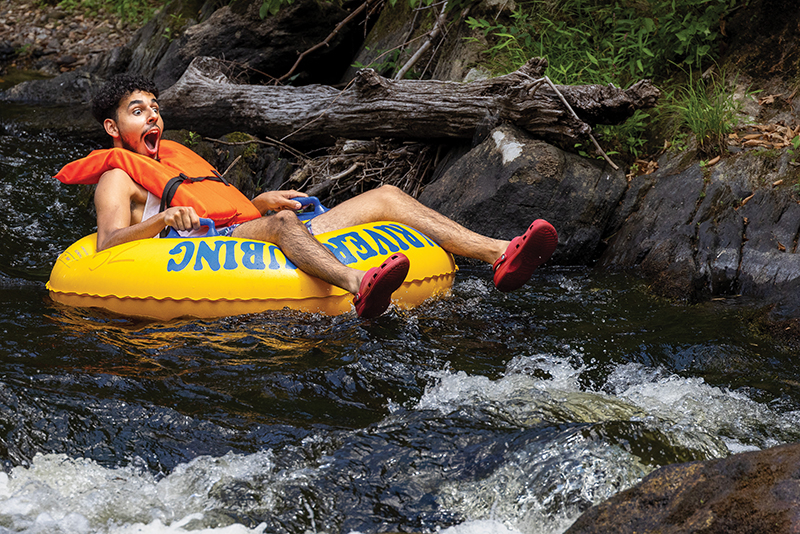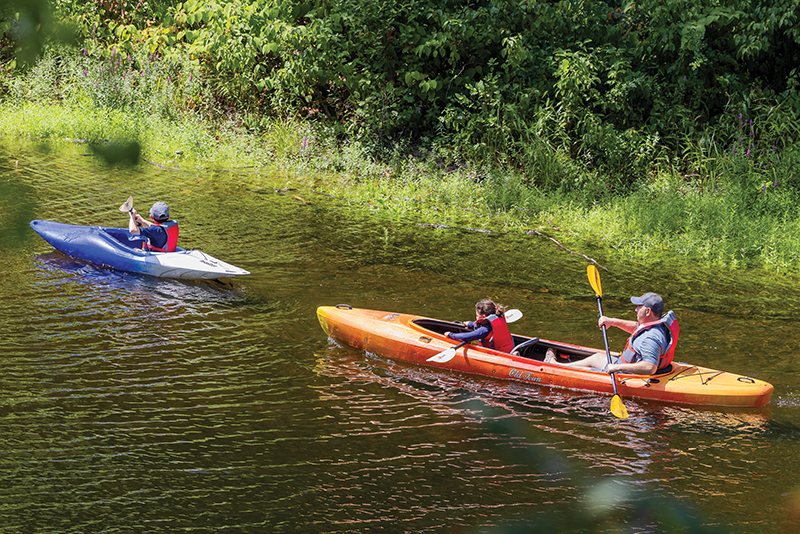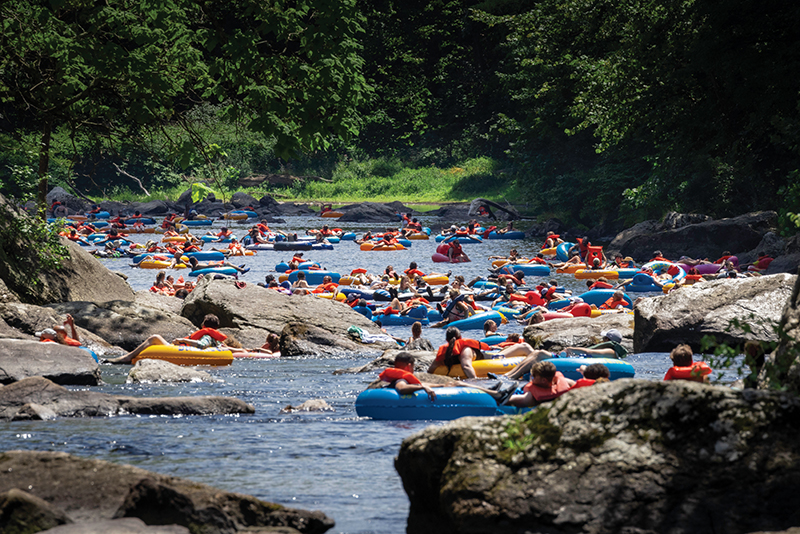
On a hot summer day, hundreds of colorful red, yellow, and blue inflatable tubes with their orange life jacket-wearing passengers gather as far as the eye can see at a slow bend in the Farmington River after passing through the gorge in Satan’s Kingdom.
Farmington River Fun
Recreation for everyone in the valley
By Eric D. Lehman
From the observation room at the top of Heublein Tower on Talcott Mountain, you stand almost 1,000 feet above the Farmington River. The magnificent castle was a summer retreat promised by Gilbert Heublein to his wife, Louise, and opened to the public in 1974. Today, it stands just off the New England National Scenic Trail and has one of the best views in southern New England. To the west is the strange, V-shaped Farmington River valley, while to the east the small towers of Hartford and Springfield look surprisingly close to each other. Just below is a popular take-out for canoeists at the massive Pinchot Sycamore, while to the north the green hump of Penwood State Park blocks your view of the finest whitewater in the state. And everywhere is an endless sea of green-leafed trees. You would never guess that over a million people live within this view.

A man spots some rapids ahead as he floats in his tube down the Farmington River. The rapids in this section of the river are quite tame by whitewater standards, but enough to add excitement to a tuber’s ride down the river. Image Credit: Christopher Zajac
The Farmington River splits the Metacomet Ridge west of its confluence with the Connecticut River, but then unusually jags directly south, before nearly doubling on itself to the north-northwest, continuing through villages and state forests, branching to form the Barkhamsted Reservoir and a narrow Berkshires rill that disappears in the forests somewhere north of Otis, Massachusetts. The watershed also includes the Salmon Brook, tumbling down from the wild headwaters in Hartland over Ender’s Falls, past parks and vineyards and breweries and farms. With a watershed of 609 square miles, the Farmington is the Connecticut’s longest tributary.
The river draws hundreds of thousands of visitors and provides hundreds of thousands of residents the opportunity to participate in dozens of varieties of outdoor recreation. On a warm summer day on any section of the river you might see canoeists paddle by, anglers flick their lines for trout, and rollerbladers navigate the frost-heaved macadam of the bike path. Even in winter, all along the river’s length, people are hiking the moose-haunted trails of Peoples’ State Forest, skiing the snowy slopes at Sundown, or skating on Colebrook River Lake.

A man navigates a stretch of whitewater on the Farmington River. Image credit: Ann Gillard
One of the most popular summer activities on the river is tubing in the ominously named Satan’s Kingdom. New Hartford’s Farmington River Tubing provides inner tubes and life jackets and sets you on your way down the pine-canyon for three miles. The rocks and rapids keep everyone somewhat on their guard, but tubing can be accomplished with a modicum of risk and skill. “Tubing down the Farmington was serene,” says Leslie Browning, who lives just past the river’s headwaters in Becket, Massachusetts. “The deep woodlands are so different from the Connecticut shoreline where I grew up. It adds to the diversity of the state’s natural experiences.”
“Tubing is a blast. It’s great family fun,” agrees long-term resident of West Hartford, Karen McAllister. And it is only one of many activities that she and her family and friends enjoy. “The valley is a concentrated area where you can have it all,” she says. “It is the locus of pick-your-own vegetables, go up the river on a bike ride, go down the river on an inner tube, and then go out for a nice dinner.”

Blue heron and ducks. Images Credit: Christopher Zajac.
The river itself can be easy or challenging during different times of year and in different sections of the long tributary. For kayakers and canoeists, Satan’s Kingdom provides Class 2 whitewater, good for beginners but still quite exciting. There is a standing wave nearby called The Rooster Tail that can be surfed for hours. Upriver in Otis, Massachusetts, the West Branch of the Farmington is runnable during the fall drawdown of Otis Reservoir, with 7 miles of narrow rapids in New Boston, Massachusetts.
But the best whitewater may be where the Farmington splits the Metacomet Ridge at Tariffville, Connecticut. Here in this rocky gorge are three miles of rapids that can be run year-round. When the snow melts in the spring, the Tariffville whitewater surges to Class 3 or 4, with scary waves and big holes. “It’s a training ground for famous kayakers,” says Ann Gillard, who serves on the Connecticut Appalachian Mountain Club Whitewater Committee and leads kayak trips year-round to the Farmington. “It’s legit whitewater.”

A family paddles in their kayaks on a hot summer day on the Farmington River in Collinsville, CT. Image Credit: Christopher Zajac.
The New England Slalom Series sponsors racing in kayaks and canoes in both Otis and Tariffville, where competitive paddlers navigate through gates both up and downstream. “Connecticut doesn’t have a strong reputation in outdoor recreation, but the Farmington is a little jewel,” continues Gillard. “There are endless opportunities for enjoyment.” She lives in Northampton, Massachusetts, 45 minutes’ drive from the Tariffville section. During the summer, she travels there with her kayak two or three times a week, sometimes more. “The proximity to so many people is another facet of the jewel,” she says. “People can just enjoy the river out their window, but at the same time people drive two hours from Boston to enjoy it.”
It is not only the water itself that draws crowds. The Farmington and its tributaries wind through and near over a hundred parks and open space areas, many of them linked by a nearly inexhaustible network of hiking and multi-use trails. The most suburban part of the valley is framed by the Tunxis Trail in the west and the New England National Scenic Trail in the east, while the upper northwest section is surrounded by state parks and forests. If you wanted to, you could wander through the suburbs and villages on these trails, staying at inns and campgrounds for weeks at a time.
The combination of the value placed on recreation and the number of people in or near the valley supports local businesses like Collinsville Canoe and Kayak, Upcountry Sportfishing, and Central Wheel Bicycle Shop. Meanwhile, dozens of groups from the Simsbury Land Trust to the Farmington Valley Trails Council attempt to keep the balance between suburban sprawl and open space throughout the valley. The communities of the Farmington Valley obviously value their river and the surrounding watershed, not only as an abstract notion, but as a place to live and play.

Three men cast their flies about the Farmington River in search of hooking a trophy trout in Barkhamsted, CT. The Farmington River is well known throughout the region for its excellent fishing. Images Credit: Christopher Zajac.
Ann Gillard extends those communities beyond the human into the natural world. “People don’t go just for the excitement and exercise, they go to learn about the plants and the birds. There’s a great blue heron we call Harold, who we see every time we go out.” She laughs, but then gets serious. “It’s a community through space and time.”
Some might want to access that natural community by casting a line for trout. Others might prefer to see it through a pair of binoculars. Still others might want to lie back on an inner tube and watch the trees and sky. “Going to the Farmington makes me think of the interconnectedness of all things,” says Gillard. “It’s been a refuge, a surprising treasure. There’s always something to do there.”

